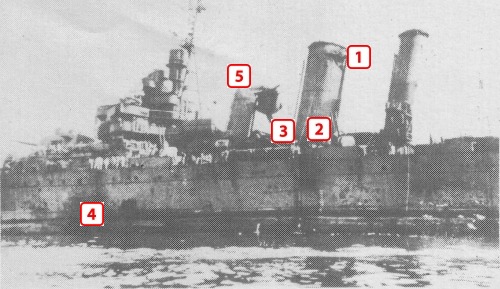- Author
- Zammitt, Alan
- Subjects
- Biographies and personal histories, RAN operations
- Tags
-
- RAN Ships
- HMAS Arunta I, HMAS Manoora I, HMAS Westralia I
- Publication
- March 1989 edition of the Naval Historical Review (all rights reserved)
(Only three Australians have been awarded the coveted Navy Cross, the others being Rear Admiral H.B. Farncomb and Lieutenant Commander J.M. Band, posthumously.)
When the Kamikaze-battered Australia entered Sydney in January 1945 Captain Armstrong made a signal to his Vaucluse home and out sailed his fourteen-year-old daughter Suzanne in her VJ. She became a great favourite with the ship’s company.
His son David joined the Navy as an Ordinary Seaman and served in HMAS Arunta in 1945. O.D. Armstrong is now Challis Professor of Philosophy, University of Sydney.
A.B. Bob Haskell, Australia’s oldest A.B. with 30 years service, was very proud that his son was a Lieutenant in HMAS Kiama while the Captain’s son was an O.D. Captain Armstrong was the type of Naval Officer who would have liked that.
It was planned that he was to be the first Commanding Officer of the R.A.N.’s first true aircraft carrier, the Light Fleet Carrier Ocean.
In May 1945 Australia under the command of Captain Armstrong sailed for the U.K. with the ship’s company for the new carrier on board. However, before Captain Armstrong arrived in England the Australian War Cabinet postponed the plan for the R.A.N. to operate an aircraft carrier.
As Australia approached the English coast a flight of Sunderland Flying Boats from No. 10 Squadron operating from Coastal Command’s base at Mountbatten flew low past the 17-year-old veteran with 14 World War II battle honours, dipping their wings in salute as they passed and then escorted the ‘Aussie’ into Plymouth Sound. Coastal Command’s way of paying tribute to the 1940 rescue of their Sunderland crew.
In July 1945 Captain Armstrong with 13 of the crew of the ‘Aussie’ received their decorations at an investiture at BuckinghamPalace by King George VI, and the Ship’s company marched through the bomb scarred streets of London.
Before the war ended, Captain Armstrong gave a farewell address to the ‘Aussie’s’ crew. There were tears in this eyes as he said ‘Goodbye you pack of bastards’. He then left for the Pacific to take command of the Escort Carrier H.M.S. Ruler, followed by H.M.S. Vindex. This was so that he could gain experience in carriers. It was planned he would be appointed Commanding Officer of the R.A.N’s first postwar carrier.

Damage to HMAS Australia
1 January 5th, 1945, 5.35 p.m. Zeke carrying a bomb, came down in a vertical dive and hit Australia on the port side of the upper deck amidships after knocking the top off the second funnel and crashing on to the P2 four inch gun which was wiped out except for one man who was badly wounded. 25 men killed, 30 wounded.
2 January 6th at 5.34 p.m. A “Val” hit the cruiser on the upper deck between 81 and 82 guns. 14 killed, 26 wounded. The Jap aircraft carried a one ton 15 inch British naval shell captured at Singapore.
3 January 8th, 7.20 a.m. A Dinah hit the water 20 yards from the ship and skidded into the ship’s side doing little damage. Part of the aircraft’s engine made a hole 3 feet square in the Captain’s day cabin. The gun crews were drenched with petrol.
4 January 8th, 7.39 a.m. A second Dinah hit the ship on the waterline below the bridge. Its bomb on exploding blew a hole 14 feet by 8 feet at the ship’s waterline.
5 January 9th, 1945, 1 p.m. A “Tony” attempted to hit Australia’s bridge. Its wing tip caught a mast strut which swung him into the foremost funnel.




